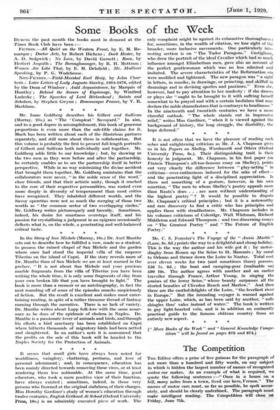* * * * It seems that small girls have
always been noted for worldliness, vainglory, chattering, pertness, and love of personal adornment ; and, in consequence, education has been mainly directed towards removing these vices, or at least rendering them less noticeable. At the- same time, good educators, who took a, more positive view of their function, have always existed ; sometimes, indeed, in those very persons who frowned at the original sinfulness of their charges. Miss Dorothy Gardiner's study of women's education through twelve centuries, English Girlhood At School (Oxford University Press, 18s.) is an admirably executed piece of work. The only complaint might be againstits exhaustive thoroughness. for, sometimes, in the wealth of citation, we lose sight of the broader, more inclusive movements. One particularly inte- resting section is on "The Tudor Paragons." Castiglione, who drew the portrait of the ideal Cavalier which had So much influence amongst Elizabethan men, gave also an account of the perfect gentlewoman which was no less admired and imitated. The severe characteristics of the Reformation era were modified and lightened. The new paragon was "a sight' in letters, in musike, in drawinge, or peincting, and skilfull in daunsinge and in devising sportes and pastimes." Even she, however, had to pay attention to her modesty : if she dances or plays she "ought to be brought to it with suffring herself somewhat to be prayed and with a certain basfulnes that may declare the noble shamefastnes that is contrarye to headinesse." In the nineteenth and twentieth centuries we have a more cheerful outlook. "The whole stands out in impressive relief," writes Miss Gardiner, "when it is viewed against the background of history, the long struggle, the disability, the hope deferred." * * * *










































 Previous page
Previous page